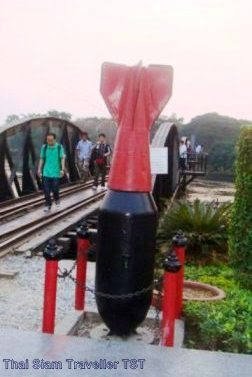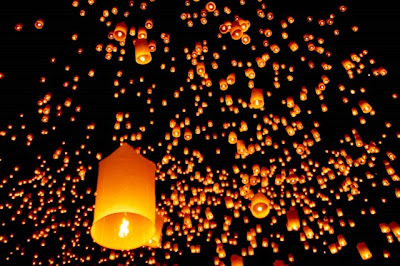One of the northern provinces (Changwat) of Thailand. Neighboring provinces are Phrae, Uttaradit, Phitsanulok, Kamphaeng Phet, Tak, and Lampang. Sukhothai can be translated as Dawn of Happiness. with the provincial's "Source of national heritage, the Thai alphabets, the best Loy Krathong celebrations, firm foundation of Buddhism, the fine Teen Jok cloth, ancient chinaware, holy Pho Khun Ramkhamhaeng’s mother, dawn of happiness"
Sukhothai located in the valley of the Yom River on the lower edge of the northern region, 427 kilometres north of Bangkok, and covers some 6,596 square kilometres.
The Khao Luang Mountain Range, with its four main peaks: Khao Phu Kha, Khao Phra Mae Ya, Khao Chedi, and Pha Narai, lies within the Ramkhamhaeng National Park in the south of the province. The Si Satchanalai National Park is located in the north-west, protecting the mountainous forest areas of the Phi Pan Nam Range at the northern end of the province.
History
Sukhothai, meaning the Dawn of Happiness, was a town founded in the 13th century on the fringe of the Khmer empire. The exact year is unknown, but according to the Fine Arts Office it was between 1238 and 1257. Founded by Phokhun Si Intharathit, it was the first truly independent Thai (Siamese) Kingdom after defeating the Khmers. Sukhothai enjoyed a golden age under their third king, King Ramkhamhaeng, who was credited with creating the Khmer-derived Thai alphabet which is essentially the same as that in use today. He also laid the foundation for politics, the monarchy and religion, as well as expanding its boundary of influence. Sukhothai was later ruled by many kings. The province is most famous for the historic city of Sukhothai, the capital of the Sukhothai kingdom. It is located about 12 km from the modern New Sukhothai city. Not far from Sukhothai are the Si Satchanalai historical park and the Kamphaeng Phet Historical Park. Both were cities within the former Sukhothai kingdom and of the same time period.
The province was at first known as Sawankhalok; it then was renamed to Sukhothai.
 |
| Sukhothai Historical Park Photo courtesy of 123rf.com |
Sights / Attractions:
Sukhothai Historical Park (อุทยานประวัติศาสตร์สุโขทัย) is registered by the UNESCO as the world’s heritage like Sukhothai historical park.The capital of the Sukhothai kingdom in the 13th and 14th centuries,in what is now the north of Thailand. It is located near the modern city of Sukhothai, capital of the province with the same name. The city walls form a rectangle about 2 km east-west by 1.6 km north-south. There are 193 ruins on 70 square kilometers of land. There is a gate in the centre of each wall. Inside are the remains of the royal palace and twenty-six temples, the largest being Wat Mahathat. The park is maintained by the Fine Arts Department of Thailand with help from UNESCO which has declared it a World Heritage Site. The park sees thousands of visitors each year, who marvel at the ancient Buddha figures, palace buildings and ruined temples. The park is easily toured by bicycle or even on foot.
The protection of the area was first announced in the Royal Gazette on June 6, 1962. In 1976 the restoration project was approved, and in July 1988 the park was officially opened. On December 12, 1991, it was declared a World Heritage Site as part of the Historic Town of Sukhothai and Associated Historic Towns together with the associated historic parks in Kamphaeng Phet and Si Satchanalai.
Ramkhamhaeng National Park
Widely known as Pa Kho Luang. It covers an area of about 341 square kilometers, or 213,125 rai. It is blessed with wildlife, birds, and natural beauties, including fertile tropical jungles and mountain. Ramkhamhaeng National Park, within the province of Sukhothai, is surrounded by the districts of Kirimas, Ban Dan Lan Hoi, and the provincial capital of Sukhothai.
Khao Luang
An important source of water for its surrounding areas. This exquisite national park, with a combined natural and historical background, covers an area of 341 square kilometres, and was declared to be a national park in year 1980. High hills and steep cliffs, some over 1,200 metres above sea level, together with fascinating falls and different species of plants and wildlife, are some of the major attractions available in this park offered to nature-loving tourists or visitors. Furthermore, the archaeological and historical sites with ancient remains and relics make the park even more attractive, especially for critics and theologians. The park also contains a lot of natural beauties, such as the Khao Luang mountain range, Sai Rung Waterfall, an herbal garden, and the Savannah located in the high country of the Khao Luang range. High country of the Khao Luang mountain range: The four main peaks of the park are within the high country. These peaks offer beautiful views. Khao Phu Ka and Khao Phra Mae Ya at 1,200 meters above sea level are the park's highest summits. Looking up from the park's headquarters, one can see the outline of a woman, in what some people would say is a very suggestive position, on one of the ridge lines.
Si Sachanalai National Park
Was proclaimed a national park on 8 May 1981. With a total area of 213 square kilometres in Amphoe Si Satchanalai and Amphoe Thung Saliam of Sukhothai Province, Si Satchanalai National Park offers trekking routes through waterfalls and caves. There is Tad Dao Waterfall, originated from the Tha Pae stream. The 30 meter high fall is wonderful, ideal for rest and relaxation. Thara Wasan Cave, blessed with fantastic stalactites and stalagmites, is located about 1.5 km away from the park's office. Wildlife is found here, including hundreds of thousands of bats. Tad Duan Waterfall, situated about 500 meters away form the office of the park, is ideal for swimming. Conveniently accessible. Everyone can enjoy.
Sangkhalok Museum (พิพิธภัณฑ์สังคโลกสุโขทัย)
Located within Mueang Ake Plaza, Thanon By-pass, just 12 kilometres off the old city. The museum displays more than 2,000 pieces of Sangkhalok ceramic wares collected from various sources both locally and internationally.
The Fish Museum (พิพิธภัณฑ์ปลาในวรรณคดีเฉลิมพระเกียรติ)
Located in the Rama IX Park, along Highway 12. It displays a variety of fresh water fish mentioned in Thai literature, such as the travel poems titled Kap Ho Khlong Nirat Phra Bat and Kap Ho Khlong Praphat Than Thongdaeng, and the Kap He Ruea boat song by Chaofa Thammathibet (Chaofa Kung).
The Ramkhamhaeng National Museum (พิพิธภัณฑสถานแห่งชาติรามคำแหง)
Houses many artifacts found from archaeological excavations in Sukhothai, as well as those donated by the locals. The museum is divided into three premises: the Lai Sue Thai Chet Roi Pi Memorial Building, Museum Building, and Outdoor Museum.
The Sawankhaworanayok National Museum (พิพิธภัณฑสถานแห่งชาติสวรรควรนายก)
Houses exhibits in a two-storey building. Upstairs houses sculptural collections from various periods, mostly those formerly collected within the compound of Wat Sawankharam and offered by Phra Sawankhaworanayok. In addition, there are Buddha images, relocated from the Ramkhamhaeng National Museum, from the pre-Sukhothai to the early Ayutthaya period.
The Centre for Study and Preservation of Sangkhalok Kilns (ศูนย์ศึกษาและอนุรักษ์เตาสังคโลก -เตาทุเรียง)
Considered the industrial area of Si Satchanalai. Numerous celadon wares in broken, as well as perfect, condition have been discovered. The kiln is oval in shape with a curved roof like that of a ferryboat and is 7–8 metres long. The centre consists of two buildings situated on the kiln site area with two kilns Nos. 42 (ground level) and 61 (underground) exhibited in situ. There are also exhibitions on artifacts, academic documents, and on the evolution of ancient ceramic wares.
Local Products:
Khanom Kliao (ขนมเกลียว)
Famous snacks of Sukhothai made from wheat flour and egg, seasoned with salt and pepper, and made it into a twist shaped-dough. Fried until crispy and further glacé. It has a sweet taste and is available everywhere.
Activities:
Agrotourism
Cycling Route along the Orchards - Some visitors enjoy cycling around the orchards and tasting a variety of fruits like pomelo, santol, sapodilla, coconut, star fruit, various kinds of bananas, as well as the tasty and fleshy plum mango (Bouae Macrophylla) with its chicken-egged size.
Tambon Ban Tuek Community of Amphoe Si Satchanalai. This is a small and peaceful community filled with trees, paddy fields, and scenic mountain ranges, while tourists can enjoy the traditional life of fruit growers. Different types of fruits grown along the hilly terrain include longkong, langsat, mangosteen, durian, banana, pomelo, rambeh, and rambutan.
Eco and Soft Adventure Tourism
Cycling Route: The Old Town of Sukhothai Trips within the Sukhothai Historical Park are also made by personal or rental bikes.
Local Products:
Khanom Kliao (ขนมเกลียว)
Famous snacks of Sukhothai made from wheat flour and egg, seasoned with salt and pepper, and made it into a twist shaped-dough. Fried until crispy and further glacé. It has a sweet taste and is available everywhere.
Sangkhalok ceramics (เครื่องสังคโลก) These replicas arguably look as good as the originals.
Thung Luang terra cotta (เครื่องปั้นดินเผา) of Khiri Mat district come in unique patterns. The products include flower pots, vases, basin, water jar, lamps, with perforated decorations of animal fiqures like frogs, bullfrogs, and dogs.
Butter-baked Banana (กล้วยอบเนย) A well-known snack of Amphoe Khiri Mat, it resembles another local sweet called Khanom Rang Nok made from sweet potato. This butter-baked banana snack is made from slicing raw banana horizontally, left to dry for half a day, seasoned with salt, deep fried, adding sugar, and giving it a good stir. Sprinkle with sesame seeds and add butter. This product is available everywhere.
Transportations:
By Roads There are 5 highways connecting Sukhothai:
Highway 12 connects the eastern districts starting at Ban Dan Lan Hoi and passing Muang and Kong Krailat districts to Phitsanulok province.
Highway 101, starting at Si Satchanalai district, connects the northern districts to the southern districts and passing Sawankhalok, Si Samrong, Muang and Khiri Mat districts to Kamphaeng Phet province.
Highway 102 connects Si Satchanalai district to Uttaradit province.
Highway 1180 connects Sawankhalok district to Si Nakhon district and Uttaradit province.
Highway 1048 connects Sawankhalok district to Thung Saliam district and Lampang province.
By Air
The airport is located in Amphur Sawankhalok and is about 30 km away from downtown. Flights operate daily between Sukhothai – Bangkok and Chiang Mai.
By Rail
Rail system in Sukhothai is one part of northern route from Bangkok’s Hua Lamphong central station. Sukhothai is located on the main Chiang Mai – Bangkok line.
Songthaew (public passenger pick-up vehicles)
Songthaews are the most popular form of public transport in the new city and the rural areas. Larger sized Songthaews travel to and from the old and new cities.
By Bus
Air-conditioned buses run regularly from Sukhothai Bus Terminal to Bangkok and Chiang Mai, stopping off at other major towns on the way. Non air-conditioned buses are for inter-provincial travel to the other districts.
Others
Tuk-tuks and motorbike-taxis are popular for short journeys within the new town.





DSC02065.JPG)





